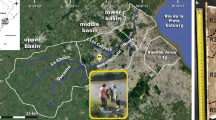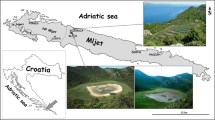Abstract
Substrates of treatment wetlands, which were constructed at an operational lead-zinc mining facility (Tara Mines) in Ireland, were analysed over a 5-year period for metal content. Lead, zinc, iron and sulphate were removed from wastewater passing though the treatment systems and were significantly retained in the substrates. The degree to which these contaminants are bio-available depends on the biogeochemical conditions of the substrates, namely the pH, redox potential, amount of organic carbon present and the contaminant loading. Various sediment fractions (water-soluble, exchangeable, carbonate-bound, organic matter-bound and residual) were also analysed in these treatment wetlands, in order to estimate the fate of metals and sulphur over time. Results showed that the majority of metals and sulphur were retained in immobile residual forms, principally as metal-sulphides. Furthermore, the neutral-alkaline pH and reducing biogeochemistry of the treatment systems suggest that metals are not toxic under these conditions.
Similar content being viewed by others
References
Allan, R.: 1995, ‘Diffuse sources of pollution by toxic metals’, in W. Salomons, U. Forstner and D. Hyman (eds), Heavy Metals: Problems and Solutions, Springer-Verlag, Berlin, Germany, pp. 33-52.
Allen, H., Gongmin, F. and Baolin, D.: 1993, ‘Analysis of Acid Volatile Sulphide (AVS) and Simultaneously Extracted Metals (SEM) for the estimation of potential toxicity in aquatic sediments’, Environ. Toxicol. Chem. 12, 1441-1453.
Athay, D. Nairn, R. and Strevett, K.: 2003, ‘Mine drainage treatment wetland substrate analysis’, in R. I. Barnhisel (eds), Proceedings of the 20th Meeting of the American Society for Surface Mining and Reclamation, American Society for Mining and Reclamation, Billings, MT., pp. 2-16.
Baker, K., Fennessy, S. and Mitsch,W.: 1991, ‘Designing wetlands for controlling coal mine drainage: An ecologic-economic modelling approach’, Ecol. Econ. 3, 1-24.
Beining, B. and Otte, M.: 1996, ‘Retention of metals originating from an abandoned lead-zinc mine by a wetland at Glendalough, Co. Wicklow’, Biol. Environ. 96 (B2), 117-126.
Brix, H. and Schierup, H. H.: 1990, ‘Soil oxygenation in constructed reed beds: the role of macrophyte and soil-atmosphere interface oxygen transport’, in P. Cooper and B. Findlater (eds), Constructed Wetlands in Water Pollution Control, WRc Swindon, Wiltshire, UK, pp. 53-65.
Broderius, S. and Smith Jr, L.: 1977, ‘Relative toxicity of free cyanide and dissolved sulfide forms to the fathead minnow (Pimephales promelas)’, J. Fish Res. Board Can. 34, 2323-2332.
Carapeto, C. and Purchase, D.: 2000, ‘Use of sequential extraction procedures for the analysis of cadmium and lead in sediment samples from a constructed wetland’, Bull. Environ. Contam. Toxicol. 64, 51-58.
Chagué-Goff, C. and Rosen, M.: 2001, ‘Using sediment chemistry to determine the impact of treated wastewater discharge on a natural wetland in New Zealand’, Environ. Geol. 40, 1411-1423.
Cline, J.: 1969, ‘Spectrophotometric determination of hydrogen sulfide in natural waters’, Limnol. Oceanography 14, 454-458.
Doyle, M. and Otte, M.: 1997, ‘Organism-induced accumulation of iron, zinc and arsenic in wetland soils’, Environ. Pollut. 96, 1-11.
Dunbabin, J. and Bowmer, K.: 1992, ‘Potential use of constructed wetlands for treatment of industrial wastewaters containing metals’, Total Environ. 111, 151-168.
Dunbabin, J., Pokorny, J. and Bowmer, K.: 1988, Rhizosphere oxidation by Typha dominigensis Pers. in miniature artificial wetland filters for metal removal fromwastewater, Aquatic Bot. 29, 303-317.
Eger, P.: 1994, ‘Wetland treatment for trace metal removal from mine drainage: the importance of aerobic and anaerobic processes’, Water, Sci. Technol. 29(4), 249-256.
Fortin, D., Davis, B., Southam, G. and Beveridge, T.: 1995, ‘Biogeochemical phenomena induced by bacteria within sulfidic mine tailings’, J. Indust. Microbiol. 14, 178-185.
Faulkner, S. and Richardson, C.: 1989, ‘Physical and chemical characteristics of freshwater wetland soils’, in D. Hammer (ed.), Constructed Wetlands for Wastewater Treatment, Lewis Publishers, Chelsea, MI, pp. 41-72.
Gambrell, R., Wiesepape, J., Patrick Jr., W. and Duff, M.: 1991,‘The effects of pH, redox, and salinity on metal release from a contaminated sediment’, Water, Air Soil Pollut. 57-58, 359-367.
Gao, Y. and Bradshaw, A.: 1995, ‘The containment of toxic wastes: II; Metal movement in leachate and drainage at Parc lead-zinc mine, North Wales’, Environ. Pollut. 90(3), 379-382.
Gusek, J. and Wildeman, T.: 2002, ‘A New Millennium of Passive Treatment of Acid Rock Drainage: Advances in Design and Construction Since 1988’, in D. Barnhisel and M. Collins (eds), Proceedings of the 21st Meeting of the American Society for Surface Mining and Reclamation, American Society for Mining and Reclamation, Lexington, KY, 9th-13th June 2002, pp. 935-951.
Hammer, D.:1989, ‘Constructed Wetlands for Wastewater Treatment, Municipal, Industrial and Agricultural, in Proceedings from the First International Conference on Constructed Wetlands for Wastewater Treatment, Lewis Publishers, Chelsea, MI.
Hedin, R., Nairn, R. and Kleinmann, R.: 1994, ‘Passive Treatment of Coal Mine Drainage’, Information Circular # 9389, Bureau of Mines, US Department of the Interior, pp. 34.
Huntsman, B., Solch, J. and Porter, M.: 1978, ‘Utilization of Sphagnum Species Dominated Bog for Coal Acid Mine Abatement Drainage’, Abstracts of the 91st Annual Meeting of the Geological Society of America, Toronto, Ontario, Canada, pp. 322.
Jacob, D. and Otte M.: 2003, ‘Conflicting processes in the wetland plant rhizosphere: metal retention or mobilization?’, Water, Air Soil Pollut. Focus 3, 91-104.
Jespersen, D., Sorrell, B. and Brix, H.: 1998, ‘Growth and root oxygen release by Typha latifolia and its effects on sediment methanogenesis’, Aquatic Bot. 61, 165-180.
Kadlec, R. and Alvord, H.: 1989, Treatment Wetlands, Lewis Publishers, CRC Press, FL.
Kelly, M.: 1988, Mining and the Freshwater Environment, Elsevier, London, UK.
Larosa, B. and Casas, A.: 1996, ‘A comparison of sampling handling and analytical methods for determination of acid volatile sediment in sediment’, Marine Chem. 52(3-4), 211-220.
Lee, G., Bigham, G. and Faure, G.: 2002, ‘Removal of trace metals by coprecipitation with Fe, Al and Mn from natural waters contaminated with acid mine drainage in the Ducktown mining district, Tennessee’, Appl. Geochem. 17, 569-581.
Lefroy, R., Samsoir, S. and Balir, G.: 1993, ‘The dynamics of sulfur, phosphorus and iron in flooded soils as affected by changes in Eh and pH’, Aust. J. Soil Res. 32, 493-508.
Levanon, D. and Danai, O.: 1994, ‘Chemical, physical and microbiological considerations in recycling spent mushroom substrate’, in Proceedings of the Spent Mushroom Substrate Symposium, Philadelphia, PA, pp. 17-24.
Machemer, S., Reynolds, J., Laudon, L. and Wildeman, T.: 1993, ‘Balance of S in a constructed wetland built to treat acid mine drainage, Idaho Springs, Colorado, USA’, Appl. Geochem. 8, 587-603.
Machemer, S. and Wildeman, T.: 1992, ‘Adsorption compared with sulfide precipitation as metal removal processes from acid mine drainage in a constructed wetland’, J. Contamin. Hydrol. 9, 115-131.
Maher, M.: 1994, ‘The Use of Spent Mushroom Substrate (SMS) as an Organic Manure and Plant Substrate Component’, in Proceedings of the Spent MushroomSubstrate Symposium, Philadelphia, PA, pp. 117-124.
Miller,W., McFee,W. and Kelly, J.: 1983, ‘Mobility and retention of heavy metals in sandy soils’, J. Environ. Quality 12(4), 579-584.
Mitch, W. and Gosselink, J.: 2000, Wetlands, John Wiley & Sons, NY.
Moshiri, G.: 1993, Constructed Wetlands for Water Quality Improvement, Boca Raton, Lewis Publishers, London, UK.
Nairn, R. and Mercer, M.: 2000, ‘Alkalinity Generation and Metals Retention in Successive Alkalinity Producing Systems’, Mine, Water Environ. 19 ,124-133.
Novotny, V.: 1995, ‘Diffuse Sources of Pollution by Toxic Metals and Impact on ReceivingWaters, in W. Salomons, U. Forstner and D. Hyman (eds), Heavy Metals: Problems and Solutions, Springer-Verlag, Berlin, Germany pp. 33-52.
O'Leary, W.: 1996, ‘Wastewater Recycling and Environmental Constraints at a Base Metal Mine and Process Facilities’, Water, Sci. Technol. 33(10-11), 371-379.
O'Sullivan, A.: 2001, ‘Constructed wetlands for passive biological treatment of mine tailings water at Tara Mines, Ireland.’, Ph.D. Thesis, Department of Botany, Division of Biosciences, University College Dublin, Ireland, pp. 229.
O'Sullivan, A., Murray, D., McCabe, O. and Otte, M.: 1999, ‘Wetlands for rehabilitation of metal mine wastes’, Biol. Environ. 99(B1), 11-17.
O'Sullivan, A., Murray, D. and Otte, M.: 2000, ‘Rehabilitating Mine TailingsWater Using Constructed Wetlands’, in L. Daniels and S. Richardson (eds), in Proceedings of the 17th Annual Meeting of the American Society for Surface Mining and Reclamation, Tampa, FL, pp. 438-445.
O'Sullivan, A., Murray, A. and Otte, M.: 2003, ‘Constructed wetlands for treating processed mine water-An Irish case study’, in G. Spiers, P. Beckett and H. Conroy (eds.), in Proceedings of the 3rd International Mining and Environment Meeting, Canadian Land Reclamation Association, Sudbury, Ontario, Canada, pp. 739-747.
Otte, M. and Wijte, A.: 1993, ‘Environmental variation between habitats and uptake of heavy metals by Urtica dioica’, Environ. Monitor. Assess. 28, 263-275.
Perkins, R. and Underwood, G.: 2001, ‘The potential for phosphorus release across the sedimentwater interface in an eutrophic reservoir dosed with ferric sulphate’,Water Research 35(6), 1399-1406.
Salt, D., Blaylock, M., Kumar, N., Dushenkov, V., Ensley, B., Chet, I. and Raksin, I.: 1995, ‘Phytoremediation: a novel strategy for the removal of toxic metals from the environment using plants’, Biotechnology 13, 468-473.
Schnoor, J.: 1996, ‘Modeling Trace Metals’, in J. Schnoor and A. Zehnder (eds) Environmental Modeling: Fate and Transport of Pollutants in Water, Air and Soil, Wiley, New York, pp. 381-451.
Sidle, R., Chambers, J. and Amacher, M.: 1991, ‘Fate of heavy metals in an abandoned lead-zinc tailings Pond: II. Sediment’, J. Environ. Quality 20, 752-758.
Sobolewski, A.: 1996, ‘Metal species indicate the potential of constructed wetlands for long-term treatment of metal mine drainage’, Ecol. Eng. 6(4), 259-271.
Tate, R.: 1995, ‘The Sulphur and Related Biogeochemical Cycles’, in R. Tate (ed.) Soil Microbiology, Wiley, New York, pp. 359-381.
Tessier, A., Campbell, P. and Bisson, M.: 1979, ‘Sequential extraction procedure for the speciation of particulate trace metals’, Anal. Chem. 51(7), 844-851.
Unicam Ltd.: 1991, SOLAAR Data Station Software, version 5.25. Unicam Ltd., Division of Analytical Technical Incl., Cambridge, UK.
White, C. and Gadd, G.: 1996, ‘Mixed sulphate-reducing bacterial cultures for bio-precipitation of toxic metals: factorial and response-surface analysis of the effects of dilution rate, sulphate and substrate concentration’, Microbiology 142, 2197-2205.
Wickham, P., Van de Walle, J. and Planas, D.: 1987, ‘Comparative effects of mine wastes on the benthos of an acid and an alkaline pond’, Environ. Pollut. 44, 83-99.
Wieder, K. and Lang, G.: 1982, ‘Modification of Acid Mine Drainage in Freshwater Wetland’, in B. R. McDonald (ed.), Proceedings of the Symposium on Wetlands of the Unglaciated Appalachian Region, WV University, Morgantown, WV, pp. 43-53.
Wood, T. and Shelley, M.: 1999, ‘A dynamic model of bioavailability of metals in constructed wetland sediments’, Ecol. Eng. 12, 231-252.
Younger P., Banwart S., Hedin R.: 2002, Mine Water: Hydrology, Pollution, Remediation. Kluwer Academic Publishers, London, UK, pp. 442.
Yu, K.-C., Tsai, L.-J, Chen, S.-H. and Ho, S-T.: 2001, ‘Chemical binding of heavy metals in anoxic river sediments’, Water Res. 35(17), 4086-4094.
Author information
Authors and Affiliations
Corresponding author
Rights and permissions
About this article
Cite this article
O'Sullivan, A.D., Moran, B.M. & Otte, M.L. Accumulation and Fate of Contaminants (Zn, Pb, Fe and S) in Substrates of Wetlands Constructed for Treating Mine Wastewater. Water, Air, & Soil Pollution 157, 345–364 (2004). https://doi.org/10.1023/B:WATE.0000038882.09628.ab
Issue Date:
DOI: https://doi.org/10.1023/B:WATE.0000038882.09628.ab




